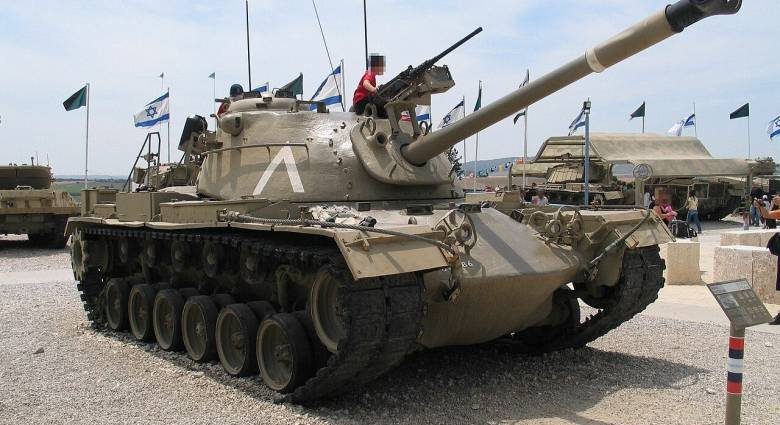In the Yom Kippur war in 1973, the last big armor battles before Ukraine, Israeli tanks encountered two enemies.
One was the new weapon Egypt used to destroy tanks, a wire-guided ground launched missile called the AT-3 Sagger (previously the 9M14 Malyuta). It was the first man-portable guided anti-tank missile. It was set up on the battlefield so the shooter was separated by some yards from the launcher, giving the shooter a better chance of survival against counter-fire.
The Sagger was teamed up with the RPG-7. a rocket propelled grenade with a shaped-charge warhead. The RPG-7 was carried by an individual foot soldier who had to get close to the target he was trying to destroy, making the RPG-7 operator vulnerable once he was discovered.
These two weapons did a lot of damage to Israeli tanks. At that time the Israeli tank force was made up of US M-60 and M48 tanks, British Centurions, and T-55 Russian tanks that had been captured in 1967 and refurbished and modernized by Israel’s tank shop located south of Tel Aviv. Israel lost over 1,000 tanks, either destroyed or damaged.
The other enemy was the one tank with the worst reputation in the 1973 War: the US M-60 Patton tank. Many M-60’s mysteriously caught fire and burned, often incinerating tank crews in the process. At first it was thought the fires were caused by enemy fire and shrapnel, but when tanks started going up in flames where there was no immediate enemy activity, the Israelis began looking for the cause.

Israeli technicians discovered that as the tank operated in a hot, dry, desert environment, like that in the Sinai, significant amounts of sand accumulated inside the tank. At the same time, a lot of oil and other lubricants leaked onto the tank’s floorboards and accumulated in gaps in the tank chassis.
When the leaked oil mixed with the sand and got wedged in between the tank hull and the fuel tank, the sand-oil mixture and metals formed a sort of battery. In the heat and when sparks inside the tank were leaping around as the tank moved along the combat line, the “battery” could set off leaked oil and fuel that reached the fuel tank, causing a major fire.
Just after the war the Israelis found a solution: coating the fuel tank with insulating foam so that the battery-like fires could not happen. That brilliant solution was passed on to the Pentagon. The US Army was not interested, mostly because the US expected to fight a war in Europe where there wasn’t any sand and where the weather tended to be much cooler and with more moisture than in the Middle East. On the other hand even back then there was no guarantee that the US would fight only in Europe, and it sold its tanks to many foreign customers.
Late this month a Dutch container ship, the Fremantle Highway, caught fire off the coast of the Netherlands, in full view of the shore. The 18,500 ton ship was carrying 3,000 cars from Germany to Egypt. At least 25 of the cars on board were electric. At least one of the electric cars caught fire and started a blaze that, at the time I was preparing this article, was consuming the ship.
Firefighters so far had not been able to contain the fire which was spreading, as the ship was crippled and starting to list. Whether the ship can be saved isn’t clear. Many crew members were wounded in the blaze, and one crew member died. Some jumped into the sea: some 23 crew members were evacuated by helicopter.
This was not the first ship stricken by fire while carrying automobiles. In 2022, the Felicity Ace caught fire off the Azores Islands. It was bringing thousands of supercars, including Porsches, to the United States. It sank while being towed. A fire onboard was attributed to faulty lithium batteries in some of the cars. Reportedly the ship had 1,117 Porsche cars on the ship. Audi claimed a loss of 1,944 vehicles. In addition there were 189 Bentley’s, 85 Lamborghini’s and 561 Volkswagen’s.

Transporting electric vehicles by sea is hazardous. As the manufacturing of electric cars gains momentum it is increasingly likely we will see more and more electric cars from South Korea, Japan and China coming by sea to the United States, and car batteries coming from Japan, Korea, China and India also shipped by sea. As has already been noted about discount electric scooters, lithium batteries especially on the cheaper models can spontaneously explode and create intense fires that are difficult to suppress.
It is likely insurers will soon either start raising their rates for electric vehicle and battery cargoes, or will refuse to insure electric vehicles and batteries in transit. So far, at least, no one has devised reliable safeguards to protect against faulty lithium batteries.
Israel figured out a workaround for its M-60 tanks. Maybe the super-advocates of electric vehicles will figure out how to prevent tragedies at sea.


